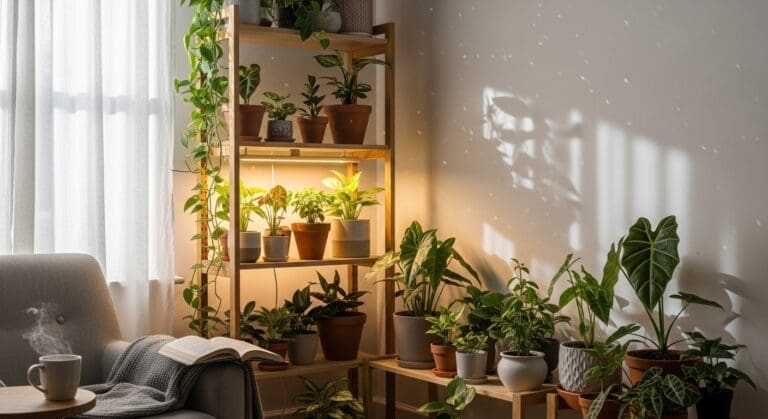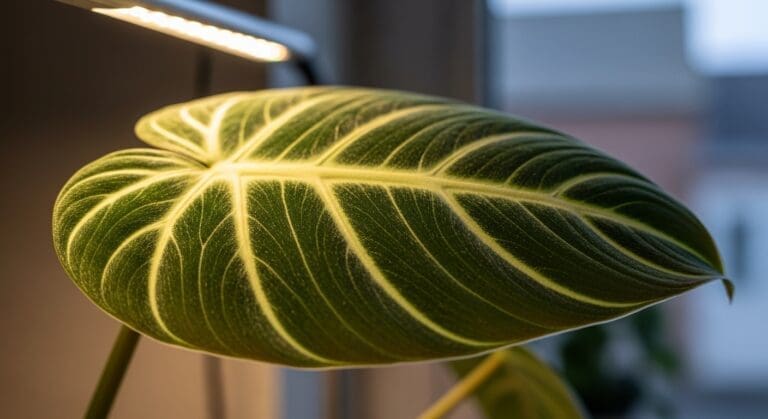Caring for rare tropical orchids indoors is one of the most rewarding challenges for any plant lover. These elegant blooms have a way of transforming a simple room into a vibrant, living sanctuary. But when it comes to orchids, light isn’t just important — it’s everything. The right lighting can mean the difference between lush, vibrant blooms and a plant that struggles season after season.
Why Light Matters So Much for Orchids
Orchids, especially rare tropical varieties, evolved under the filtered light of dense rainforest canopies. This means they’re accustomed to bright but indirect light, rather than the harsh, direct sun many houseplants can tolerate. Without the right lighting, orchids won’t photosynthesize efficiently, which can lead to fewer blooms, pale leaves, or slow growth.
As the Royal Horticultural Society notes, most indoor orchids prefer bright, indirect light and should be protected from harsh midday sun. (RHS orchid guide).
Understanding Orchid Light Requirements
The light needs of rare tropical orchids vary by species, but most indoor growers focus on two main categories:
- Low to Medium Light Orchids — Often from deeper rainforest floors, these thrive in softer, filtered light (e.g., Paphiopedilum, or slipper orchids).
- Bright Indirect Light Orchids — From higher canopy zones, these can handle more light (e.g., Vanda and Cattleya orchids).
| Genus (examples) | AOS suggested intensity* (foot-candles) | Home leaf-level target (approx. LUX)** | Typical placement |
|---|---|---|---|
| Phalaenopsis, Paphiopedilum | ~1,000–1,500 fc | ~8,000–15,000 LUX | East window; shaded south/west |
| Oncidium, many Cattleya | ~2,500–3,000 fc | ~20,000–30,000 LUX | Bright east; south with sheer; back from glass |
| Vanda (high-light types) | ~5,000 fc | ~35,000–50,000 LUX | Brightest spot; strong diffusion & airflow |
Sources: American Orchid Society light guidance and culture sheets. Measure at leaf height with a phone lux app; adjust by plant response.
Tip: You can usually tell if your orchid is getting the right amount of light by checking the leaf color — healthy leaves are a bright, medium green. Dark green means not enough light, while yellowish leaves may mean too much.
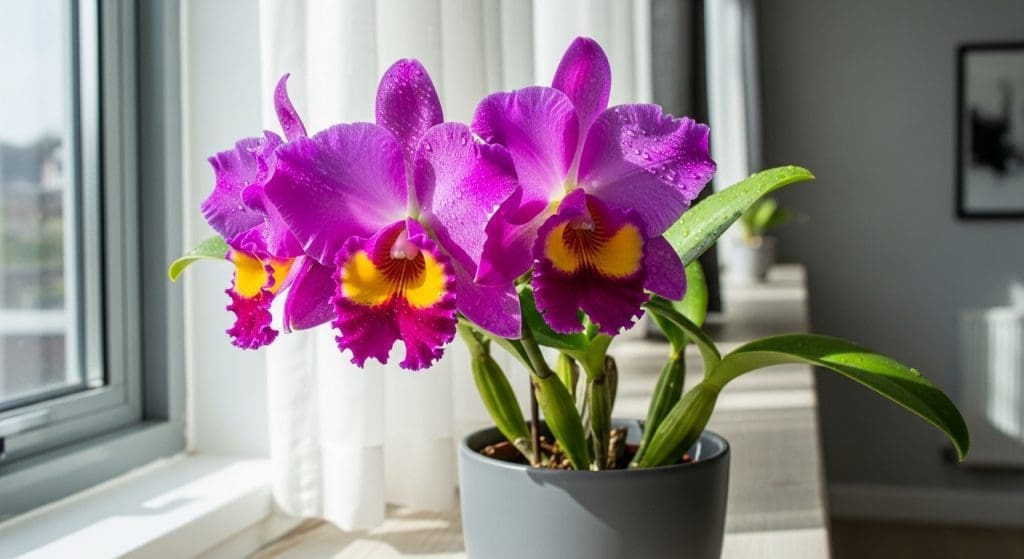
The Best Indoor Spots for Your Orchid
When growing rare tropical orchids indoors, placement is key. The most common sweet spots are:
- East-facing windows — Perfect for gentle morning light that won’t scorch the leaves. Target ~8–15k LUX at leaf height; sheer optional.
- South-facing windows (with a sheer curtain) — Bright all day, but filtered to prevent direct midday sun. Place 60–120 cm from glass; ~15–30k LUX with diffusion.
- Bright, shaded corners in sunlit rooms — Great for orchids that prefer softer light. Often ~5–10k LUX; ideal for Phalaenopsis.
“I used to think any sunny windowsill would do, but after a few crispy leaves, I learned that filtered light is non-negotiable.”
If your home doesn’t have enough natural light, don’t panic — artificial grow lights can work wonders.
Using Artificial Light for Orchids
Artificial light can be a game-changer for plant enthusiasts in cloudy climates or small apartments. Full-spectrum LED grow lights are the best choice, as they mimic the natural spectrum of sunlight.
Setup tips:
- Start with moderate intensity and watch leaves: medium green = good; dark green = too little; yellow/red = too much.
- Keep fixtures ~30–45 cm (12–18 in) above leaves; add a sheer/diffuser if you see hotspots.
- Extend daylength in winter; aim for a consistent day (longer in winter) rather than chasing exact hours.
- Measure at leaf height with a lux app; adjust to the genus targets in the table above.
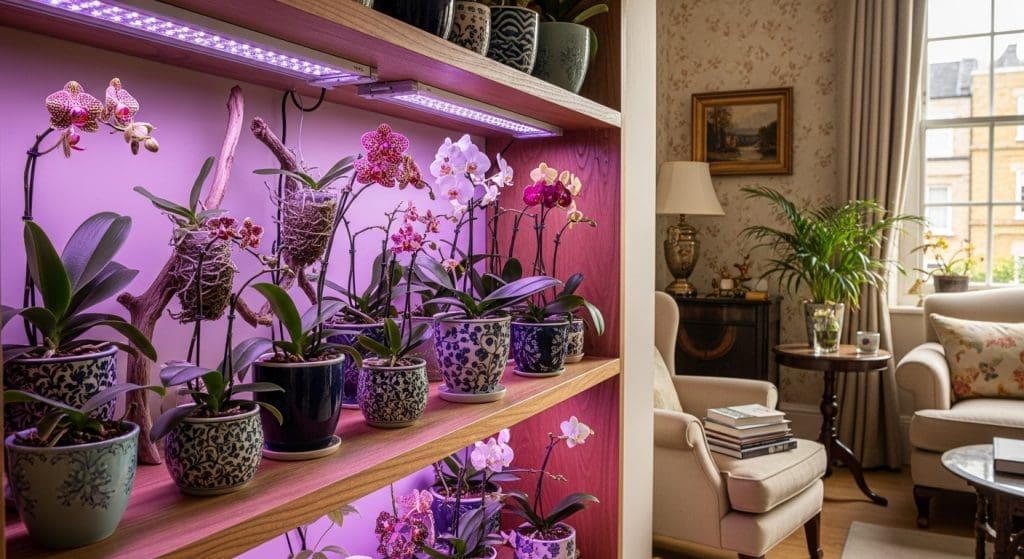
Window × Distance Quick Map (leaf-level LUX)
| Window & shade | Distance from glass | Midday LUX (approx.) | Good for |
|---|---|---|---|
| East, sheer | 40–60 cm | 8,000–15,000 | Phalaenopsis, Paphs |
| South, sheer | 60–120 cm | 15,000–30,000 | Oncidium, many Cattleyas |
| South, double sheer | 40–80 cm | 10,000–20,000 | Intermediate Oncidium/Cattleya |
| North, no sheer | 20–40 cm | 5,000–10,000 | Phalaenopsis (winter: add LED) |
Reference: AOS notes window glass can reach thousands of fc; values drop sharply off-axis. Use this as a practical indoor map and adjust by plant response.
Seasonal Light Adjustments
One mistake many orchid owners make is keeping the same lighting routine year-round. In the UK and US, daylight hours change dramatically through the seasons, which can impact your orchid’s growth.
- Winter: Supplement with grow lights to compensate for short days and weaker sunlight.
- Summer: Watch for overheating near windows and move orchids back slightly if needed.
“Every December, I bring my orchids closer to the kitchen shelf with a grow light — it’s their winter retreat.”
Signs Your Orchid’s Light Needs Are Not Being Met
Recognizing the early signs of light stress can save your orchid from long-term damage. Watch for:
- Leaves turning dark green (too little light)
- Leaves becoming yellow or reddish (too much light)
- Flower spikes that are short and weak
- Failure to bloom after a full growing season
If you see these symptoms, adjust placement or light intensity promptly.
How Light Interacts with Other Care Factors
Light doesn’t work in isolation. Your orchid’s needs for water, humidity, and temperature all interact with light exposure. Brighter light often means your orchid will need slightly more water, while lower light can slow growth and reduce water needs.
If you’re unsure about balancing these factors, check out our Rare Tropical Orchids Indoors: The Complete Care Guide — it covers how lighting works alongside every other care element.
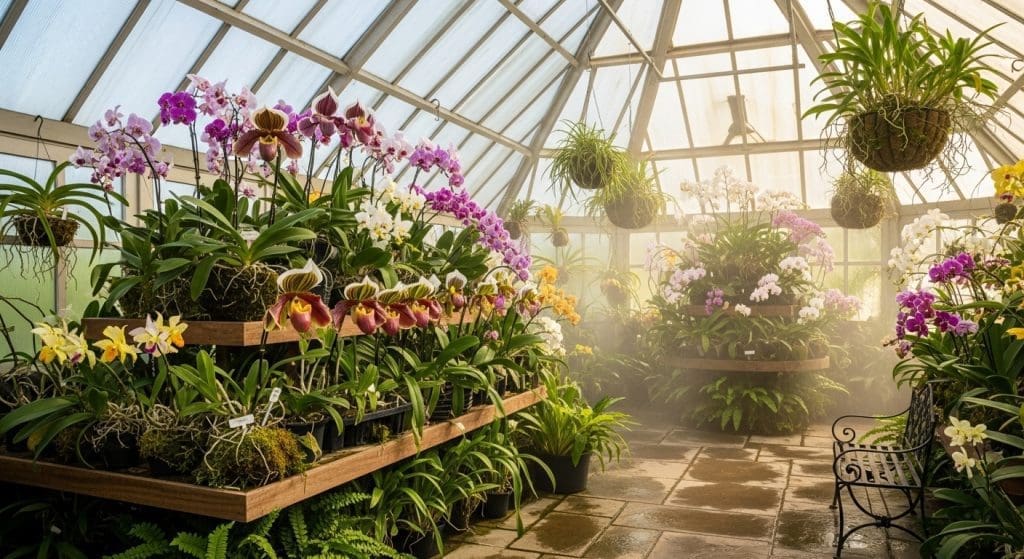
Expert Insight: Matching Light to Orchid Species
Different rare orchids have very specific light preferences. For example:
- Phalaenopsis — medium, indirect; east windows ideal (RHS/AOS).
- Dendrobium — bright indirect; protect from midday sun (AOS general guidance).
- Oncidium — bright; some tolerate gentle morning sun (AOS).
“Matching the right orchid to the available light in your home will give you the best results,” says Williams. “It’s easier to adapt your plant choice than to completely change your home’s lighting environment.”
Practical Light Hacks for Apartment Dwellers
Living in a flat or apartment doesn’t mean you can’t grow rare orchids. Here are some tricks:
- Use mirrors to reflect light into darker corners.
- Place orchids on plant stands near windows for better light exposure.
- Rotate your orchid weekly so all sides receive even light.
The best light conditions for rare tropical orchids indoors come down to a balance of brightness, duration, and protection from direct sun. Whether you rely on a sunny east-facing window or a sleek LED grow light, the goal is to replicate the dappled, gentle light of a rainforest canopy. When you get it right, your orchids will reward you with stunning blooms and lush foliage.
Change log: Aug 2025 — Added genus light map (AOS-based), window×distance table, and corrected RHS attribution; improved grow-light guidance.

RarePlantCare Editorial Team produces expert content on rare plants.
Our articles are AI-assisted and human-edited before publication.
We aim to provide practical, evidence-based guides for plant lovers worldwide.
Learn more about our Editorial Policy



